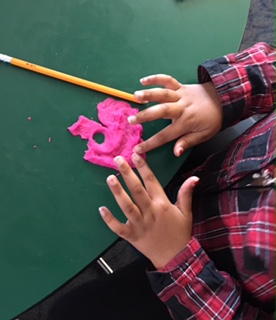Level Up Your Integration of the Arts: Map Skills
4 Min Read • Arts Integration
Are you looking for ways to engage your students during social studies? Here are a few ideas for the integration of the arts with geography, map skills, and communities.
There are many levels of arts integration. Remember that true integration pairs a content standard with an Arts standard and assesses both. For each activity below, I share the activity in a way that brings art into the classroom, followed by a way that you can explicitly add Arts standards.
1. Legos in the Classroom
I teach a short unit on communities, and many of my students struggle to retain the words rural, urban and suburban. After teaching the vocabulary words and viewing examples of these types of communities, students illustrate the words in a bullseye formation.
To further ingrain the meaning of these words, I borrowed some Legos and rearranged my classroom into three building stations, one for rural, one for suburban, and one for urban. After asking students to generate a list of characteristics of each of these communities, I split the class into three groups and challenged students to create buildings or landscapes to represent the types of communities. We had a time limit, and students had to work with a team to successfully design buildings and landscapes with the characteristics of their assigned community. If you’d like to try this communities activity, here are the student directions.
Arts Integration “Level Up” Idea: Allow students to explore different types of architecture found in these communities. Have them attempt to build their buildings and landscapes with Legos following the characteristics of the architecture.
2. Working with Clay
It is best practice to integrate map skills and landforms with social studies topics rather than teach them in isolation. I have found that my students have trouble with the vocabulary, however, and it is helpful for them to have at least some background information on the skills and words needed before they start a unit of study.
What better way to identify landforms than to actually make them. A colleague of mine shared a simple yet fantastic activity that allows students to manipulate to create landforms as the vocabulary words are introduced.
Each student starts with a small ball of very pliable clay, Model Magic or Play-Doh. I started by showing the word “island” with its definition and pictures of islands. Then students created an island by flattening their ball of clay.
Next, I introduced the word “peninsula” in the same way, and the students added a peninsula to their island. I continued to share each landform following this process, and the students added each one to their land. My students who typically have trouble focusing and following directions seemed to be the most engaged as they manipulated the clay into tiny little worlds. Next year, I would love to add a writing component so that students could write about an imaginary community that might inhabit their creation.
Arts Integration “Level Up” Idea: Teach techniques for working with this type of medium. Then, allow students to spend time refining, completing, and sharing their work.
3. Dancing the Compass
One other map skill that I review is compass directions. Later in the year, we create a compass during a unit on rocks and minerals, but for now, we simply need to know the cardinal directions. After practicing these directions through some activities, we do the Compass Cha Cha, based on the Cupid Shuffle, following this video. There is also a version of the Cha Cha Slide for compass directions here.
Arts Integration “Level Up” Idea: Allow students to create their own short dance that includes all of the cardinal directions and chosen elements of dance. Have the student perform their dances for each other. The students in the audience respond by pointing out the elements of dance they noticed or track the cardinal directions they used.
4. Leveling Up
These activities engage students by allowing them to participate in an art form, which helps them retain the information. “Leveling Up” takes you up the ladder of integration, consequently respecting the art form, increasing your rigor, and adding depth. If you have Arts Integrated activities already in place, reflect on them. Can you level up? If you can’t pinpoint the Arts standard that is integrated into your activity, you probably can. Check out the national arts standards and get started!





